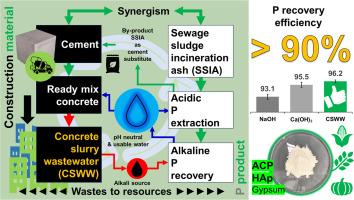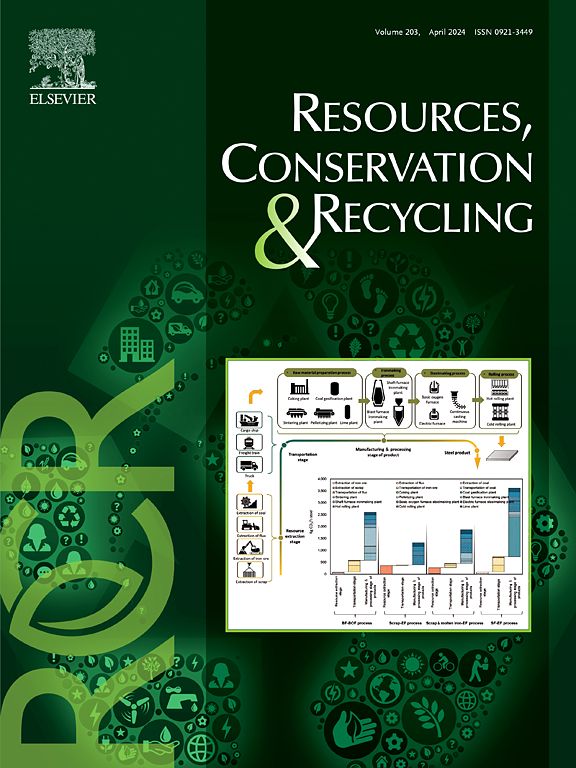从污水污泥焚烧灰和混凝土浆废水中协同回收磷和可用水源
IF 11.2
1区 环境科学与生态学
Q1 ENGINEERING, ENVIRONMENTAL
引用次数: 0
摘要
从污水污泥焚烧灰(SSIA)中回收 P 的传统湿法工艺需要大量的化学品(如用于后续 P 提取和沉淀的酸和碱)和水,造成了经济和环境方面的弊端。我们采用混凝土泥浆废水(CSWW)作为碱源和水源,最大限度地减少了这些问题,在 pH 值为 7 的条件下,实现了超过 90% 的 P 回收率。粉末 X 射线衍射和化学平衡模拟显示,产品由羟基磷灰石晶体(HAp)和无定形 CaHPO4 组成,在 pH 值为 4 时形成,pH 值较高时部分转化为 HAp。上清液用于后续的磷萃取循环,以节约用水。对副产品进行了危险性评估,并将其回收利用到水泥基材料中,以实现零废物原则。这项研究体现了从 SSIA 中回收 P 与生产水泥基材料之间的协同作用,将废物转化为有价值的资源。本文章由计算机程序翻译,如有差异,请以英文原文为准。

Synergistic resource recoveries of phosphorus and usable water from sewage sludge incineration ash and concrete slurry wastewater
The conventional wet process for P recovery from sewage sludge incineration ash (SSIA) demands substantial chemicals (e.g., acids and alkalis for subsequent P extraction and precipitation) and water, causing economic and environmental drawbacks. We minimized them by employing concrete slurry wastewater (CSWW) as alkali and water sources, achieving over 90 % P recovery at pH 7. The P product contained ∼ 12 % P and low metal contaminants, meeting the regulations for inorganic fertilizer. Powder X-ray diffraction and chemical equilibrium simulations revealed that the product comprised hydroxyapatite crystal (HAp) and amorphous CaHPO4, forming at pH ∼ 4 and partially converting to HAp at higher pH. The supernatant was utilized in subsequent P extraction cycles to conserve water. By-products were assessed for hazard and recycled into cementitious materials, adhering to the zero waste principle. This study exemplifies the synergy between P recovery from SSIA and cementitious material production, transforming wastes into valuable resources.
求助全文
通过发布文献求助,成功后即可免费获取论文全文。
去求助
来源期刊

Resources Conservation and Recycling
环境科学-工程:环境
CiteScore
22.90
自引率
6.10%
发文量
625
审稿时长
23 days
期刊介绍:
The journal Resources, Conservation & Recycling welcomes contributions from research, which consider sustainable management and conservation of resources. The journal prioritizes understanding the transformation processes crucial for transitioning toward more sustainable production and consumption systems. It highlights technological, economic, institutional, and policy aspects related to specific resource management practices such as conservation, recycling, and resource substitution, as well as broader strategies like improving resource productivity and restructuring production and consumption patterns.
Contributions may address regional, national, or international scales and can range from individual resources or technologies to entire sectors or systems. Authors are encouraged to explore scientific and methodological issues alongside practical, environmental, and economic implications. However, manuscripts focusing solely on laboratory experiments without discussing their broader implications will not be considered for publication in the journal.
 求助内容:
求助内容: 应助结果提醒方式:
应助结果提醒方式:


